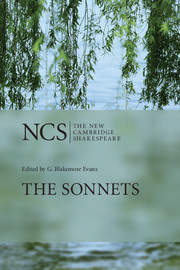Book contents
- The New Cambridge Shakespeare
- The New Cambridge Shakespeare
- The Sonnets
- Copyright page
- Contents
- Illustrations
- Preface
- Abbreviations and Conventions
- Introduction
- Note on the text
- The Sonnets
- The Commentary
- Textual analysis
- Appendix: Manuscript copies of the sonnets
- Reading list
- Index of first lines
- References
Reading list
Published online by Cambridge University Press: 02 August 2019
- The New Cambridge Shakespeare
- The New Cambridge Shakespeare
- The Sonnets
- Copyright page
- Contents
- Illustrations
- Preface
- Abbreviations and Conventions
- Introduction
- Note on the text
- The Sonnets
- The Commentary
- Textual analysis
- Appendix: Manuscript copies of the sonnets
- Reading list
- Index of first lines
- References
- Type
- Chapter
- Information
- The Sonnets , pp. 272 - 273Publisher: Cambridge University PressPrint publication year: 2006

